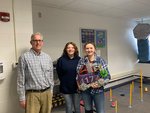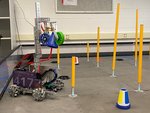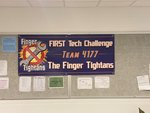What does robotics look like in the classroom? At Highland High School in Riverside, robotics has been a staple for over 13 years, thanks to science teacher Tim Surine, who began the program almost …
This item is available in full to subscribers.
We have recently launched a new and improved website. To continue reading, you will need to either log into your subscriber account, or purchase a new subscription.
If you had a login with the previous version of our e-edition, then you already have a login here. You just need to reset your password by clicking here.
If you are a current print subscriber, you can set up a free website account by clicking here.
Otherwise, click here to view your options for subscribing.
Please log in to continue |
|



What does robotics look like in the classroom? At Highland High School in Riverside, robotics has been a staple for over 13 years, thanks to science teacher Tim Surine, who began the program almost as soon as it became available.
In short, robotics in the classroom is like a well-oiled machine where students learn and practice skills that will help them continue careers in different fields.
“We’ve had lots of kids that have gone on to careers in either computer science or engineering,” Surine said. “[It’s] nice to see that they’ve been inspired by something that they did here and gone on to learn more. [There is] some kind of spark that helped them to decide whether or not that was something that they might want to pursue later on.”
There is a focus on engineering, programming, and marketing, which makes the eight-student robotics class a student-led business. The sole focus of the class is to create a robot that can compete in certain parameters against other schools. This school year, the goal was to create a robot that can pick up cones and place them on posts, or junctions. The higher the post, the more the points are worth.
“It’s like a big game of tic-tac-toe,” junior Gwyn Piette said. “You got to make sure that you can complete it, but other teams can erase your X and put in their own O, so you want to control [the playing field].”
Students each have roles. Piette is one of the programmers who helped install an “autonomous mode,” which is required for competition as the first thirty seconds of each contest start with the robot moving on its own.
One of the things that helps the Finger Tightans’s (the team’s name) robot stand out is that it has a light sensor to detect colors and it then is programmed with different actions, depending on the color. This helps the team robot in its autonomous mode. If it sees yellow, it will stop; green will send it to the left and purple to the right. Many teams do not have a light sensor like this, according to Piette, which helps their robot stand out.
“My favorite thing is, you see all the hard work that goes into it, and then once it does it, you get that shock of joy, and you’re like: It did it, we actually have something here,” Piette said.
The class is monitored and helped by Surine, who assists the students in things like funding.
“It’s really more student led, but I try to make sure they have the right resources they need, and answer the questions that they have,” Surine said.
Robotics at Highland is not just a class; there is an afterschool club as well, to ensure that any student who wants to help and be a part of the team can do so.
“It’s nice that we have the support here to be able to have the class, because I know a lot of the teams have problems [with students having other extracurriculars that take up their time]. It’s tough to get all of the kids there,” Surine said.
The students can use their experience to get scholarships and continue in engineering, programming, or marketing. Someone with no engineering/programming skills could still be a part of the team since marketing is such an important aspect of the team.
Piette, for instance, wants to take this experience into college for a Computer Science program.
“The basics are to build a robot that can deliver medicines or package things, because that is what a lot of computer science goes in to,” Piette said. “If I can, I want to build a robot that can help people.”
The marketing aspects can be seen clearly, as businesses that choose to sponsor the team can receive certain perks, one of which is their logo placed on the side of the robot, like a NASCAR racecar. A prominent logo on Highland’s robot is MidAmerican Energy.
Another perk is getting the sponsor’s name on the website.
“[The students] will send sponsor letters out to businesses, and they’ve gotten a pretty good response back from those,” Surine said. “They’ve gotten grants from different places like the [Washington County] Riverboat Foundation before.”
There are numerous different ways that they can fundraise. According to junior Bianca Garcia, they’ve done duct-tape fundraising before, which is utilizing duct tape to promote the team. The best way to raise funds is to just reach out to potential sponsors, however.
“We use [fund raising] for competition entry fees, we use it for new tools, updating any stuff we want to put on the robot, modernizing it, and stuff like that,” Garcia said.
The name “Finger Tightans” began as an inside joke, yet the name has remained. They also created a mascot, something that every team has. In the last thirty seconds of each match, teams can pick up their mascot with the robot and place it on any junction, granting them ultimate access to that junction, meaning the other team cannot place another cone there. Using their mascot grants them an additional ten points on wherever they place it.
A mascot, team name, and laser are not the only things that separate the Finger Tightans from the pack. The Finger Tightans created a smaller robot to maneuver easily in the playing field. They also use a unique type of wheel, granting them easy side-to-side movement, which is crucial for how the playing field is laid out.
One of the great things about having a history with robotics is possessing the ability to reuse features from previous robots.
“Actually, most teams don’t even know [the wheels] exist because they’re from previous years,” Piette said.
Highland’s robotics team has had much success in the past, qualifying for the world championship four years in a row, 2016-2020 (although COVID-19 prevented the 2020 team from competing).
“We’ve had a lot of success. They’ve made it to the state championship quite a few times,” Surine said. “We’ve had a few years in a row where they made it, they advanced through the state championship to the world championship where they competed against kids literally from all over the world.”
The class culminates in competition between Highland and other schools in the area. Highland is a part of a “super league,” which includes teams as far east as the Quad Cities. Seventeen teams will advance, and according to Piette, they are ranked 16th, meaning that they should move on after their next competition, since they can gain points from more than the head-to-head matchups. They can earn points for things like their outreach, marketing, and unique features of the robot as well.
With an engaged group of students and an instructor that lets them set the course, Highland’s Robotics team is sure to enjoy continued success.